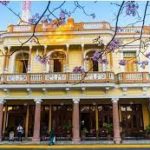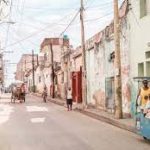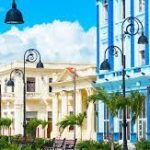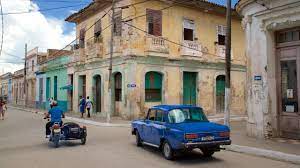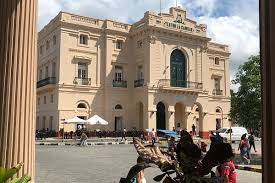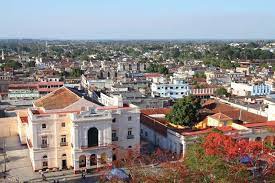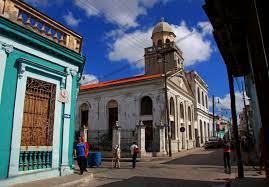CIUDAD DE SANTA CLARA, VILLA CLARA, CUBA: CENTRO GEOGRÁFICO DE LA ISLA DE CUBA. PHOTOS
Santa Clara, capital de la provincia de Villa Clara y cabecera del municipio de igual nombre, es una ciudad localizada en el centro geográfico de la República de Cuba.
Atravesada por los ríos Bélico y Cubanicay pertenecientes a la cuenca del río Sagua la Grande, la separan por carretera 267 km de La Habana, capital del país, 172 km de Varadero, 94 km de la Cayería Noreste de Villa Clara, 42 km de Remedios, 60 km de Cienfuegos, 89 km de Trinidad, 68 km de Topes de Collantes, 78 km de Sancti Spíritus y 45 km de Sagua la Grande.
En 2004, el municipio de Santa Clara tenía una población de 237.581 habitantes. Con una superficie total de 514 km2 (198 millas cuadradas), tenía una densidad de población de 462,2/km2 (1197/millas cuadradas).
Muchos fueron los nombres por los que se conoció a esta ciudad antes de ostentar el que hoy exhibe derivado de aquel, Sabana del Ciego de Santa Clara, que identificara a la hacienda de Antonio Díaz y de Pavía en el cacicato de Cubanacán, donde originalmente tuvo su asiento en 1689. Fundada como resultado del frustrado traslado forzoso de San Juan de los Remedios hacia el interior, algunas de las primeras denominaciones estarían íntimamente ligadas a la de su progenitora. Este hecho, del cual no escaparon, dada su condición nómada, otras de las primeras villas fundadas por los españoles en Cuba (Camagüey y La Habana, por ejemplo), encontraría en Remedios una férrea resistencia a pesar de la quema casi total del villorrio. El resultado, a la postre, sería el surgimiento de dos localidades unidas por la misma arteria, único caso de este tipo registrado en la historiografía del territorio nacional
En sus comienzos, el asentamiento se llamó Cayo Nuevo, luego Dos Cayos, Villa Nueva de Santa Clara, Pueblo Nuevo de Antón Díaz, Villa Clara y finalmente Santa Clara.
Poco después de la fundación de la ciudad, también se erigieron un teatro, una cámara de comercio, clubes de reuniones, bibliotecas públicas y salones de baile. Situada casi en el centro del país, la ciudad se convirtió en una parada popular para los viajeros y en un importante centro de transporte; estas condiciones respaldaron su crecimiento constante. En el siglo XIX, Santa Clara era más grande y más poblada que los pueblos cercanos, incluido lo que alguna vez fue Remedios. Como escala necesaria entre La Habana y el oriente del país, la ciudad se convirtió en capital de la provincia de Las Villas.
La I Guerra Mundial implicó para Cuba el inicio de una nueva etapa socioeconómica, motivada por la exportación del azúcar. Esta etapa es conocida por la “Danza de los Millones” o época de las “Vacas Gordas”. En este período aumenta el índice de inmigrantes, fundamentalmente españoles, provocando un alto grado de urbanización por el aumento de la población y un florecimiento constructivo. Tal situación económica incide en el desarrollo social y urbano de Santa Clara, que renueva el entorno de su plaza principal con la demolición en 1923 de la iglesia Parroquial Mayor, para convertir su expresión colonial en otra de carácter republicano influenciada por la escuela de bellas artes europea.
tro índice que denota estabilidad económica para el período es el incremento de la población municipal, que según los datos del censo de 1931, se colocó en el primer lugar provincial, catalogándose como la década de mayor aumento poblacional de Santa Clara en la primera mitad del siglo XX.
MARTA ABREU EN LA HISTORIA DE SANTA CLARA
La aclamación de Marta Abreu se debe a los numerosos proyectos que ella y su familia promovieron a través de donaciones monetarias destinadas a mejorar la vida de todos los ciudadanos de Santa Clara. Marta Abreu y su esposo Luis Estévez, que se convirtieron en el primer Vicepresidente de la joven república en 1902, fueron simpatizantes y contribuyentes a la causa de los rebeldes cubanos durante la Guerra de Independencia de Cuba contra España (conocida en Estados Unidos como la española – Guerra americana).
El legado de Marta se observa por toda la ciudad: un edificio de plantas eléctricas, varias escuelas, un asilo, estaciones de lavandería públicas por el río Belico (dos de ellas todavía existen, desafortunadamente en malas condiciones), la estación de bomberos que se puede ver sólo un Bloquear el Parque Vidal, la estación de tren cerca de la colina del Carmen, pero sobre todo el “Teatro La Caridad” (un teatro llamado en honor a la patrona de Cuba, La Virgen de la Caridad). El teatro se puede admirar en uno de los rincones del Parque Vidal en el centro de la ciudad. Marta fue el único patrocinador financiero del proyecto. Supervisó personalmente su diseño y construcción. Aunque el edificio no es tan grandioso como el Teatro Tomás Terry en la ciudad de Cienfuegos, el concepto detrás de su fundación lo hace más digno: los ingresos del teatro fueron destinados al apoyo de las dos escuelas que Marta fundó para los niños pobres de la ciudad. Las escuelas, una para niñas y otra para niños, se encontraban justo detrás del teatro. Marta está enterrada en el cementerio de Colón de La Habana.
ATRACCIONES
En el centro de Santa Clara se encuentra un parque (Parque Vidal) y se ubica sobre un bloque cuadrado entero. En el parque hay una estatua de Marta Abreu, una persona muy querida por la gente de Santa Clara. Al borde del parque se encuentra el Santa Clara Libre, el Gran Hotel, el Teatro de La Caridad, la Plaza del Mercado Central, el antiguo Ayuntamiento y la Colonia Española de Santa Clara centro de baile, ofrece las costumbres tradicionales más atractivas y únicas del interior de Cuba.
Parque Vidal es probablemente uno de los lugares más típicos de Cuba. Durante las tardes, las personas (especialmente los solteros) visitan el parque para conocer a otros. Aunque no ampliamente practicado en los últimos tiempos, la costumbre era caminar por el parque alrededor y alrededor. Las mujeres recorren la parte interior del parque, mientras que los hombres caminan por el lado exterior. Otra costumbre perdida era que los lugareños crearan una plataforma y ofrecieran improvisaciones con sus guitarras en las tardes de los domingos por la tarde. Para ese día se vistieron con sus Guayaberas y zapatos muy pulidos.
Antes del 1 de enero de 1977, Santa Clara estaba situada en la provincia de Las Villas. En esa fecha, como parte de una reorganización administrativa general de las provincias de Cuba, la provincia de Las Villas fue reordenada en las provincias de Villa Clara, Cienfuegos y Sancti Spíritus. Santa Clara está en la provincia ahora conocida como Villa Clara.
EDUCACION
Santa Clara es el hogar de la Universidad “Marta Abreu” de Las Villas (UCLV), integrada por un conglomerado de facultades: Ingeniería Eléctrica, Ciencias Agrícolas, Matemáticas, Física y Computación Ciencias,Humanidades, Derecho, Psicología, Ciencias Sociales, Construcción, Ciencias Gerenciales, Ingeniería Mecánica, Química y Farmacia.
Santa Clara es atravesada por la Carretera Central (CC) y la Autopista A1. Una carretera de circunvalación que da servicio a la ciudad está directamente conectada con la autopista. La principal estación ferroviaria, la Estación Santa Clara, forma parte de la línea principal del país, la Habana-Santa Clara-Camagüey-Santiago. El Aeropuerto Abel Santamaría, ubicado a 11 km (6,8 millas) al norte, es el aeropuerto de la ciudad y atiende vuelos a Italia, Canadá, Francia y Polonia, además de vuelos nacionales y otros.
PERSONALIDADES NOTABLES
Marta Abreu (1845-1909), benefactora
José Bernal, artista
Rolando Laserie, popular cantante
Yuniesky Betancourt, campocorto de las Grandes Ligas de Béisbol
Mike Cuellar, lanzador de Grandes Ligas
Aledmys Díaz, campocorto de Grandes Ligas
Newton Estape Vila, fotógrafo y periodista
José Fernández (1992-2016), lanzador de Grandes Ligas
Mirka Francia, jugadora de voleibol cubano-italiana
Rubén González, pianista
Benny ‘Kid’ Paret (1937-1962), boxeador
Moraima Secada, cantante
Miguel Díaz-Canel, decimoséptimo presidente de Cuba
Gerardo Machado y Morales, general, quinto presidente de Cuba (1925-1933)
Marilyn Pupo, actriz y presentadora de televisión cubano-puertorriqueña
Dafnis Prieto baterista, compositor, director de banda y educador cubanoamericano
CITY OF SANTA CLARA, VILLA CLARA, CUBA: GEOGRAPHICAL CENTER OF THE ISLAND OF CUBA. PHOTOS
Santa Clara, capital of the province of Villa Clara and head of the municipality of the same name, is a city located in the geographical center of the Republic of Cuba.
Crossed by the Bélico and Cubanicay rivers belonging to the Sagua la Grande river basin, it is separated by road by 267 km from Havana, the country’s capital, 172 km from Varadero, 94 km from the Northeast Cayería of Villa Clara, 42 km from Remedios , 60 km from Cienfuegos, 89 km from Trinidad, 68 km from Topes de Collantes, 78 km from Sancti Spíritus and 45 km from Sagua la Grande.
In 2004, the municipality of Santa Clara had a population of 237,581 inhabitants. With a total area of 514 km2 (198 sq mi), it had a population density of 462.2/km2 (1,197/sq mi).
There were many names by which this city was known before displaying the one it displays today, derived from that one, Sabana del Ciego de Santa Clara, which identified the hacienda of Antonio Díaz y de Pavía in the chiefdom of Cubanacán, where it originally had its seat in 1689. Founded as a result of the frustrated forced transfer of San Juan de los Remedios to the interior, some of the first denominations would be closely linked to that of their progenitor. This fact, from which other of the first towns founded by the Spanish in Cuba (Camagüey and Havana, for example) did not escape, given their nomadic condition, would find fierce resistance in Remedios despite the almost total burning of the town. The result, in the end, would be the emergence of two towns linked by the same artery, the only case of this type recorded in the historiography of the national territory.
In its beginnings, the settlement was called Cayo Nuevo, then Dos Cayos, Villa Nueva de Santa Clara, Pueblo Nuevo de Antón Díaz, Villa Clara and finally Santa Clara.
Shortly after the founding of the city, a theater, a chamber of commerce, meeting clubs, public libraries, and dance halls were also erected. Located almost in the center of the country, the city became a popular stop for travelers and an important transportation hub; These conditions supported its constant growth. In the 19th century, Santa Clara was larger and more populous than nearby towns, including what was once Remedios. As a necessary stopover between Havana and the east of the country, the city became the capital of the province of Las Villas.
World War I meant for Cuba the beginning of a new socioeconomic stage, motivated by the export of sugar. This stage is known for the “Dance of the Millions” or the time of the “Fat Cows.” In this period, the rate of immigrants, mainly Spanish, increased, causing a high degree of urbanization due to the increase in population and a constructive flourishing. Such economic situation affects the social and urban development of Santa Clara, which renews the surroundings of its main square with the demolition in 1923 of the Parroquial Mayor church, to convert its colonial expression into another of a republican character influenced by the school of fine arts. European.
Another index that denotes economic stability for the period is the increase in the municipal population, which according to the 1931 census data, was placed in first place in the province, being classified as the decade with the greatest population increase in Santa Clara in the first half of the year. twentieth century.
MARTA ABREU IN THE HISTORY OF SANTA CLARA
Marta Abreu’s acclaim is due to the numerous projects that she and her family promoted through monetary donations aimed at improving the lives of all citizens of Santa Clara. Marta Abreu and her husband Luis Estévez, who became the first Vice President of the young republic in 1902, were sympathizers and contributors to the cause of Cuban rebels during Cuba’s War of Independence against Spain (known in the United States as the Spanish – American War).
Marta’s legacy can be seen throughout the city: a power plant building, several schools, a nursing home, public laundry stations by the Belico River (two of them still exist, unfortunately in poor condition), the fire station that You can see only a Block Parque Vidal, the train station near the Carmen Hill, but especially the “Teatro La Caridad” (a theater named in honor of the patron saint of Cuba, La Virgen de la Caridad). The theater can be admired in one of the corners of Parque Vidal in the center of the city. Marta was the only financial sponsor of the project. She personally supervised its design and construction. Although the building is not as grand as the Tomás Terry Theater in the city of Cienfuegos, the concept behind its foundation makes it more worthy: the income from the theater was destined to support the two schools that Marta founded for the poor children of the city. The schools, one for girls and one for boys, were located right behind the theater. Marta is buried in the Colón cemetery in Havana.
ATTRACTIONS
In the center of Santa Clara there is a park (Parque Vidal) and it is located on an entire square block. In the park there is a statue of Marta Abreu, a person very loved by the people of Santa Clara. At the edge of the park is the Santa Clara Libre, the Gran Hotel, the Teatro de La Caridad, the Central Market Square, the old Town Hall and the Colonia Española de Santa Clara dance center, offering the most attractive and unique traditional customs of the interior of Cuba.
Parque Vidal is probably one of the most typical places in Cuba. During the afternoons, people (especially singles) visit the park to meet others. Although not widely practiced in recent times, the custom was to walk around the park around and around. Women walk around the inside of the park, while men walk around the outside. Another lost custom was for locals to create a platform and offer improvisations with their guitars on Sunday afternoons. For that day they dressed in their Guayaberas and very polished shoes.
Before January 1, 1977, Santa Clara was located in the province of Las Villas. On that date, as part of a general administrative reorganization of the provinces of Cuba, the province of Las Villas was reorganized into the provinces of Villa Clara, Cienfuegos and Sancti Spíritus. Santa Clara is in the province now known as Villa Clara.
EDUCATION
Santa Clara is home to the “Marta Abreu” University of Las Villas (UCLV), made up of a conglomerate of faculties: Electrical Engineering, Agricultural Sciences, Mathematics, Physics and Computer Sciences, Humanities, Law, Psychology, Social Sciences, Construction, Management Sciences, Mechanical Engineering, Chemistry and Pharmacy.
Santa Clara is crossed by the Central Highway (CC) and the A1 Highway. A ring road serving the city is directly connected to the highway. The main railway station, Santa Clara Station, is part of the country’s main line, Havana-Santa Clara-Camagüey-Santiago. Abel Santamaría Airport, located 11 km (6.8 mi) to the north, is the city’s airport and serves flights to Italy, Canada, France and Poland, in addition to domestic and other flights.
(READ NOTABLE PERSONALITIES IN THE SPANISH SECTION SECTION ABOVE)
Agencies/ Wiki/ Ecured/ Extractos/ Excerpts/ Internet Photos/ Arnoldo Varona/ www.TheCubanHistory.com
THE CUBAN HISTORY, HOLLYWOOD.



 CIUDAD DE SANTA CLARA, Villa Clara, Cuba: Centro Geográfico de la Isla. PHOTOS. * CITY of Santa Clara, Villa Clara, Cuba: Geographical Center of the Island. PHOTOS.
CIUDAD DE SANTA CLARA, Villa Clara, Cuba: Centro Geográfico de la Isla. PHOTOS. * CITY of Santa Clara, Villa Clara, Cuba: Geographical Center of the Island. PHOTOS.